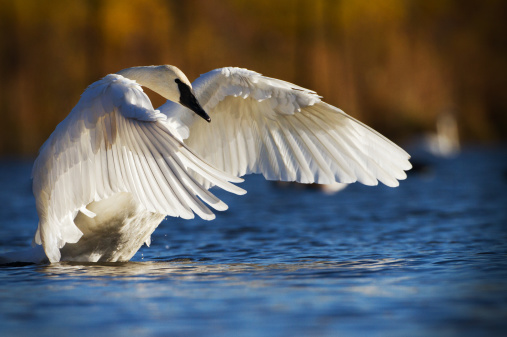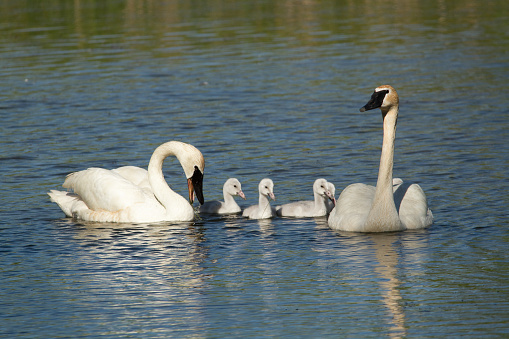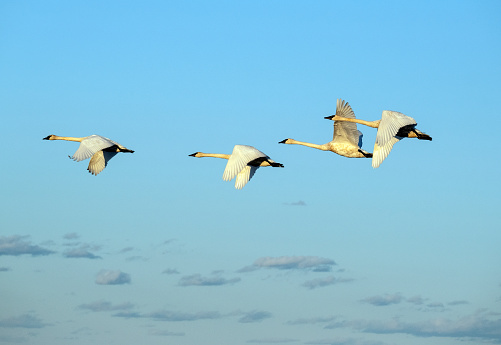Disclaimer
Hi, just letting you know that all products recommended here have been used by us, or are properly researched to ensure they are the best you are getting without bias.
We are also an affiliate for certain Amazon products and thus some links here are affiliate links. If you purchase an item through any of them, we MAY earn a commission at no extra cost to you.

How big is a trumpeter swan? Trumpeter Swans are the largest waterfowl species in North America and one of the largest extant species of waterfowl. They are most often found in freshwater wetlands, bays, and estuaries bordering eastern North America.
The size of a trumpeter swan is different between males and females. The trumpeter swan’s length is 1.4–1.6 m and weight between 9.5 and 14 kg in adults depending on the gender.
The male swan, however, can exceed 180 cm (5 ft 11 in) in total length. Trumpeter swans are the largest extant species of waterfowl, both the heaviest and longest native bird of North America.
How big is a trumpeter swan?
The male trumpeter swan is the largest North American waterfowl, measuring 4 feet 6 inches (138 centimeters) in length and weighing 30 pounds.
The female trumpeter swan is the second-largest North American waterfowl, measuring 4 feet 6 inches (138 centimeters) in length and weighing 10 pounds.
Cygnets are the youngest of a Trumpeter Swans. They start off as white as their parents, but within a year or two, they begin to grow their first dark feathers. Within about three years, they will be a dark grayish-brown color and retain this color for life.
How big is a female trumpeter swan?
Female trumpeter swans are larger than most swans, but they are still smaller than the male. Female trumpeter swans weigh around 10 pounds and are about the length of a large Labrador retriever. Males weigh around 15 pounds and large males can exceed 180 cm (5 ft 11 in) in total length.
How big is a male trumpeter swan?
A male trumpeter swan is around 1.5 meters long. Trumpeters weigh between 9-14 kg (20-32 lbs) and stand at 4 feet tall. The trumpeter swan is the largest extant species of waterfowl, and both the heaviest and longest native bird of North America.

How big are the cygnets of trumpeter swan?
Adult trumpeter swans are the heaviest and longest native bird in North America. Cygnets of a trumpeter swan are born black with a yellow bill and greyish-black legs. Their down is dense and fluffy. The cygnet’s color changes to brown in its first year, and by its second year, the cygnet has turned completely white.
The cygnets of trumpeter swans are born with a downy covering of white feathers, but in a few weeks, they molt and grow their juvenile dark feathers. Most females lay two eggs, though three or more are possible and occasionally one female will lay only one egg.
If two eggs are laid, the first-laid egg is larger, probably because it has been developing longer. The cygnet has a straight beak that is yellow with a black cutting edge and can grow up to 15 inches long.
How heavy is a trumpeter swan?
We have all heard the phrase “He’s a big person.” This is usually in reference to height, weight, or both. Trumpeter swans are no different. Trumpeter swans can weigh up to 14 kg (30 lbs), which is about the same as a sheep.
They can be up to 5 ft 5 in (165 cm) long and have a wingspan of more than 7 ft (210 cm). The trumpeter swan is the largest waterfowl species in North America, so they are big birds!
How many pounds is the trumpeter swan?
The trumpeter swan is a large waterfowl. An average Trumpeter Swan weighs in the range of 21–30 pounds, with males tending to be larger than females. However, the heaviest recorded Trumpeter Swan weighed over 35 pounds and may have exceeded 40 pounds.
How much does an adult trumpeter swan weigh? The trumpeter swan is the largest extant species of waterfowl, and both the heaviest and longest native bird of North America.
Adults usually measure 138–165 cm (4 ft 6 in – 5 ft 5 in) long, though large males can exceed 180 cm (5 ft 11 in) in total length. The weight of adult birds is typically 7–13.6 kg (15–30 lb).
With a wingspan of more than 7 feet and a height of about 4 feet, the Trumpeter Swan (Cygnus buc- cinator) ranks as the largest native waterfowl species in North America. Let’s discuss at length how big a trumpeter swan is.
How big is the biggest swan in the world?
Male trumpeter swans are significantly larger than females. Males can measure up to 5 feet from bill to tail, and weigh more than 30 pounds. Females are about 4 feet long and weigh about 20 pounds.
Male swans, female swans and cygnets. Trumpeter swan’s length is Length: 1.4 – 1.6 m and weight between 9.5 and 14 kg as adults depending on the gender. Thus, the trumpeter swan is the largest extant species of waterfowl, and both the heaviest and longest native bird of North America.
Adults usually measure 138–165 cm (4 ft 6 in – 5 ft 5 in) long, though large males can exceed 180 cm (5 ft 11 in) in total length. The weight of adult birds is typically 7–13.6 kg (15–30 lb).
With a wingspan of more than 7 feet and a height of about 4 feet, the Trumpeter Swan (Cygnus buc- cinator) ranks as the largest native waterfowl species in North America.”
Can big trumpeter swans fly?
Trumpeter Swans are very good at flying, with a wingspan of more than 7 feet and a height of about 4 feet. They are less agile on the ground, but they can walk quickly given their large size.
They first use their wings to take off and fly, before folding them in flight to conserve energy. Trumpeter Swans fly with slow wingbeats and with necks outstretched.
Trumpeter swans spend most of their time in water, but they do fly. Males occupy large territories and may fly while honking to warn off other male Trumpeter Swans. Trumpeters use these same vocalizations to locate each other when coming into land.
Swan’s flight is slow, with a flapping frequency of about 8-11 beats per second, but it can reach speeds of up to 100 km/h (62 mph) over short distances. When flying, the neck is extended and flattened out, creating a long black smudge on white background and making it easier for predators to see them from below.
Although trumpeter swans are very capable in the air, they are even more at home on the water where they travel with necks stretched out and heads down as they swim in a continuous motion with webbed feet.
Where do Trumpeter Swans go in the winter?
The breeding trumpeter swans move from coastal Alaska and Canada during their breeding season to ice-free waters in the Pacific Northwest and British Columbia. Trumpeter swans wintering in the United States and Canada leave for warmer areas.
This is to ensure that their eggs are able to get warm temperatures to hatch and also the parents have food to eat. This will not be possible if they remain in snowy areas during their mating season.
How fast do Trumpeter Swans fly?

Trumpeter Swans fly at a speed of 25 to 60 miles an hour. Swans are often observed soaring, or gliding without flapping their wings, in the daytime.
They can do this because they are very efficient at using their massive wings to catch updrafts, and can travel long distances this way. Trumpeter swans typically spend about 10 hours a day swimming and feeding, then take flight to roost for the night.
How long do Trumpeter Swans live?
In the wild, Trumpeter Swans can live up to 20 or more years. In captivity, they can live up to 25 years.
You can also find some trumpeter swans that live for up to 30 years. The reason is that the adult trumpeter swans have few predators. The bird is also aggressive during their mating season thus reducing the death of their young.
Why are they called trumpeter swans?
The trumpeter swans are very loud. Moreover, they are nearly musical creatures. Their sound is similar to a trumpet and thus the older generation named the according to their sound which is a cry sounding like a trumpet.
The trumpeter swans produce a loud noise all the time. However, you will hear some hissing sounds when they want to attack or when they are protecting their habitat and young ones.
Fun facts about trumpeter swans
Trumpeter swans are big: The trumpeter swan is a very large bird, the largest species of waterfowl native to North America. Males range in length from 138-165 cm, with males on average measuring 1.6 m (5 ft 3 in) in length and female swans averaging 1.4 m (4 ft 7 in) in length. Trumpeters are among the heaviest and longest living of all birds, with typical weights of 14 kg (30 lb) for an adult male and 9.5 kg (20 lb) for an adult female
They mate for life: Trumpeter swans mate for life. They will live with one partner and raise their cygnets together. Moreover, the make trumpeters are very aggressive during the mating season. If the partner dies, the other swan may remain single or get a partner after some time.
Trumpeter swans are very territorial: The trumpeter swans protect their habitats, especially during the mating season from other birds, humans, and other animals. Therefore, it’s not good to approach them, especially at this time since they may attack.
Trumpeter swans have their own constellation: Trumpeter swans have their family or constellation that they live together and travel together. It helps them to protect their habitat and young ones. Moreover, the constellation enables them to conserve energy during flying. Finally, this constellation is important for their survival.
They live for a long time (20 years): As described in this article, trumpeter swans live for a long time. They live for up to 20 years even though some can survive up to 30 years in the wild. The reason is that there are a few animals that can attack them. In addition, they are healthy birds and a sight to behold.
Trumpeter swan numbers are increasing: Swans are an endangered species, however, trumpeter swans are increasing. This is because hunting them for their feathers was legalized. Therefore, the birds are on the least concern list.
Are Trumpeter Swans extinct?
No, their population is increasing and thus are ‘least concern’. They are not going extinct. The population of trumpeter swans is actually increasing and their status is ‘least concern’ according to the IUCN Red List.
They were originally hunted for their feathers in the early 1900s, but legislation passed in 1918 made it illegal to hunt them.
Conclusion
The trumpeter swan is the largest extant species of waterfowl, and both the heaviest and longest native bird of North America. Adults usually measure 138–165 cm (4 ft 6 in – 5 ft 5 in) long, though large males can exceed 180 cm (5 ft 11 in) in total length.
The weight of adult birds is typically 7–13.6 kg (15–30 lb). With a wingspan of more than 7 feet and a height of about 4 feet, the Trumpeter Swan (Cygnus buc-cinator) ranks as the largest native waterfowl species in North America. Let’s discuss at length how big a trumpeter swan is.
FAQs
What is the weight of a male trumpeter swan?
The male trumpeter swan is about the same size as a female trumpeter swan. The male trumpeter swan can have a wingspan of nearly 7 feet. They are slightly bigger than the female trumpeter swan and weigh up to 14 Kilograms.
How many times heavier is the trumpeter swan than a common mallard?
Trumpeter swans are about four times heavier than the common mallard.
How long do trumpeter swans live?
Male and female swans usually live for about 20 years, but some individuals may live for well over 30 years.
How can you tell apart the male and female swans?
By their coloration, although there are some size differences between genders as well. Male trumpeter swans are slightly larger than females and have brighter white feathers with black on their wings, neck, and beak; females have brown feathers with black on their wings and neck only.
What is the difference between a female trumpeter swan and a male trumpeter swan?
Male trumpeters have black feathers on their neck called a neckstrap that they can fan out like a cape when they flare their wings, whereas females have white feathers on their necks as well as less aggressive displays during courtship because they are likely to be more coy than males
Image source: https://unsplash.com/s/photos/trumpeter-swan